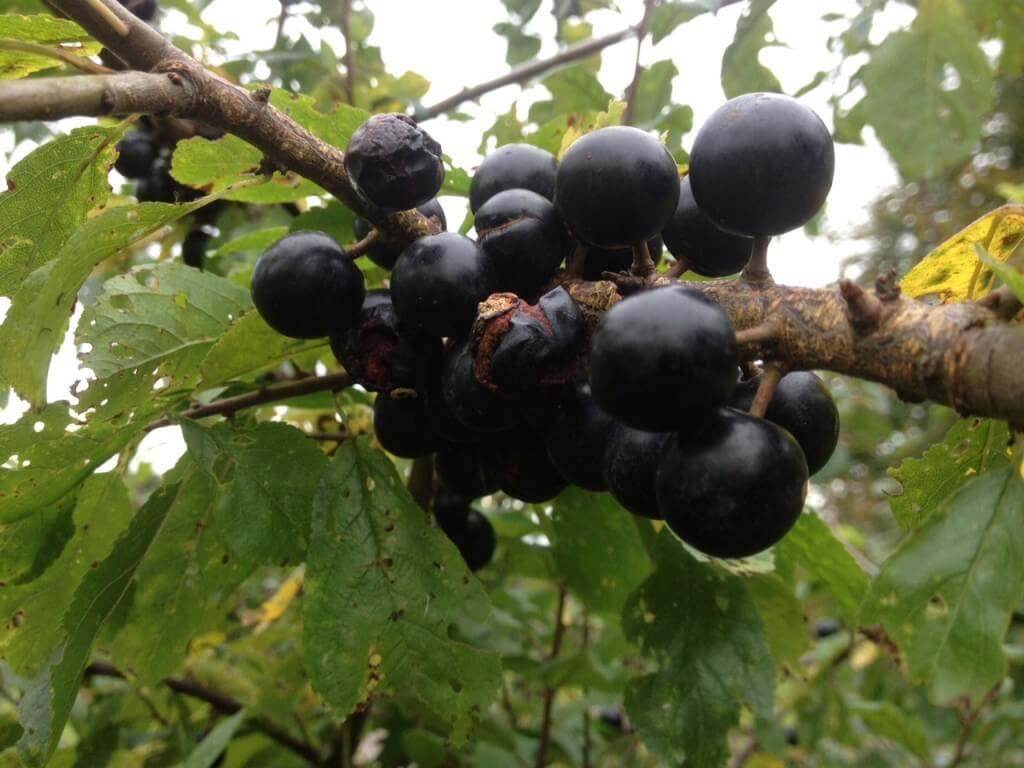Combine a blustery autumn walk with a bit of simple foraging, and you have the ingredients needed for one of the tastiest traditional winter drinks of all – Sloe Gin.
First, find your sloes
You can buy sloes in selected shops, but they grow on trees! And if you keep an eye out in October and November, and even December, you are sure to find some. Sloe berries are smaller than plums but bigger than cherries, and grow in distinctive clusters on the Blackthorn tree (Prunus spinosa), which you will often find in hedgerows, open woods and scrubland. The fruits cluster together on spiny stems, are blue, ripening to black, and around ½ inch wide. For Sloe Gin, try to pick and use them in their riper, or blacker stage. Rest assured it is very difficult to mistake anything else for sloes, so once you have found them, you just need to gather, carefully. Prunus spinosa is in the rose family of plants, and it has thorns to match; the spines can be vicious, so take a pair of gloves.
Where to look
In London, Waitrose often stocks ripe sloes, but they can also be found on Hampstead Heath, near Hampton Court Palace (by the river), Walton Lock, Wormwood Scrubs (behind Queen Charlotte’s Hospital), and even in Hyde Park.
Sloe Gin didn’t really exist before the 17th century in the UK, when the Land Enclosure acts were passed, turning common land into private property. Landowners planted hedgerows as boundaries, and Blackthorn is a very effective hedgerow plant, as its spines deter livestock from escaping. Soon the countryside was awash with sloes, and it was discovered that while they are pretty unpalatable fresh, when steeped in alcohol, the flavours transform into something wonderful.
Once you have gathered your berries, put them in a large bowl of cold water and leave them for 10 minutes to allow any insects to move out, then drain and put in the freezer overnight (defrost before using). This bursts the skin, allowing for the fruit to impregnate the gin with flavour, but if you want to make your mix straight away, simply cut a small nick into the side of each fruit before bottling.
Ensure that your jars and bottles are sterile before using; you can simply put them through a hot wash in the dishwasher, or place them in the warming oven of an Aga for three hours (or on a long, low heat with a conventional oven).
Recipe
- Find a large Kilner jar, sterilize it, then half fill it with 500g of pricked or defrosted sloe berries.
- Next add 500g of sugar and 600ml of good gin. Some people also like to add an almond to the mix.
- Shake the jar to combine the ingredients, and give the jar another shake every few days for a week. It will be drinkable after two months, but leave it longer and the flavour will be much improved.
- If you are leaving the Sloe Gin to steep for longer than three months, strain out the berries using muslin, and return the liquid to sterilized bottles and store in a cool, dark place.
Sloe Gin cocktails
Many people like to drink their Sloe Gin unadulterated, but it does make an excellent component of cocktails. Here are two of our favourites:
Sloe Gin Fizz
2 ounces Sloe Gin
1 ½ ounces fresh lemon juice
½ ounce simple syrup
3-4 ounces chilled club soda
Maraschino cherries
Shake all the ingredients, except the club soda, vigorously with ice. Strain into an ice-filled highball glass. Top with club soda and stir gently. Garnish with the cherry.
Moulin Rouge
1 ½ ounces Sloe Gin
¾ ounce sweet vermouth
2 dashes Angostura Bitters
Stir the ingredients in a mixing glass with ice. Strain into a chilled cocktail glass.




